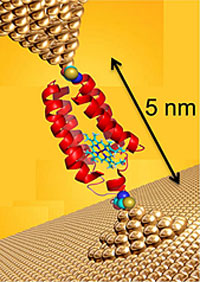| Nov 23, 2012 | |
Electronics of nature's nano machines |
|
| (Nanowerk News) A team from the University’s Schools of Biosciences and Physics and Astronomy have made a breakthrough in our understanding of proteins - the workhorse molecules of the cell and nature’s very own nano machines. | |
| The group has successfully detected electric current through a single molecule of a protein, measuring just 5 nanometres long. | |
 Single molecule of electron transfer protein cytochrome b562 bound between two gold electrode surfaces. Electric current is key in many natural processes including detection of light in the eye, photosynthesis and respiration. The team showed that the protein could carry large currents, equivalent to a human hair carrying one amp. The team also discovered that current flow could be regulated in much the same way as transistors, the tiny devices driving computers and smartphones, work but on a smaller scale: the proteins are only a quarter of the size of current silicon based transistors. To access this molecular information, the team has pioneered the use of synthetic biology with a technique called STM (Scanning Tunneling Microscopy) so that electrical current flowing through a protein can be measured right down to the single individual molecule. Prior to this work, measurement of millions, if not billions of proteins was only possible, so losing crucial details of how an individual molecule functions. Dr Jones, School of Biosciences, said: "If you step back and listen to the sound of a large crowd, this sound is an accumulation of many individual voices and conversations. What we have done is the molecular equivalent to listening to individual voices in the crowd. |
|
| "By marrying our knowledge and ability to manipulate proteins at the molecular level with advanced approaches developed in the School of Physics and Astronomy and DTU Denmark we can examine the individual complex molecules fundamental to all life. The transistor behavior is particularly interesting but in time, it may be possible to integrate proteins with electronic components." | |
| Collaborators Dr Martin Elliott and Dr Emyr Macdonald, School of Physics and Astronomy added: "The highly conducting nature of this protein was a surprise and the result raises questions about the fundamental nature of electron transfer in proteins. | |
| "This gives a new powerful tool for studying enzymes and other important biological molecules''. | |
| The team’s findings have been published as a series of papers in the journals Nano Letters ("Single-Molecule Mapping of Long-range Electron Transport for a Cytochrome b562 Variant"), ACS Nano ("Orientation-Dependent Electron Transport in a Single Redox Protein"), Small ("Direct Binding of a Redox Protein for Single-Molecule Electron Transfer Measurements") and Nanoscale ("Fast electron transfer through a single molecule natively structured redox protein "). | |
| Much of the research was carried out by Eduardo Della Pia under the University’s Richard Whipp Studentship scheme, designed to promote interdisciplinary research. | |
| The research is now funded by a recently awarded grant from the Engineering and Physical Sciences Research Council (EPSRC). |
| Source: Cardiff University |
